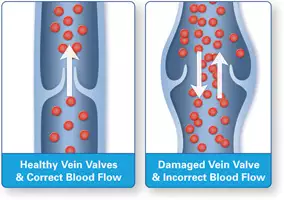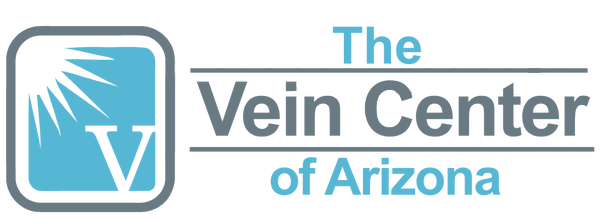Chronic Venous Insufficiency
Chronic Venous Insufficiency (CVI) is a condition that occurs when the venous wall and/or valves in the leg veins are not working effectively, making it difficult for blood to return to the heart from the legs.
CVI causes blood to “pool” in the veins, and this pooling is called stasis.
Over 60,000 Miles of Blood Vessels

Your body has a network of blood vessels—consisting of arteries and veins—that could wrap around the earth twice if they were laid out end to end. Arteries and veins work together to distribute blood throughout the body. Arteries carry oxygen-rich blood away from the heart to the rest of the body. Veins return oxygen-depleted blood from the extremities to the heart. When arteries become diseased, the symptoms are usually immediate and can be life-threatening. Vein disease, on the other hand, can be a silent killer, building and lingering in the veins of the body until the discomfort becomes unbearable or there is a life-threatening issue.
What is Chronic Venous Insufficiency?
Veins push blood back to the heart. In order to perform this task, moving blood against gravity, there are one-way valves inside of the veins that push the blood upward, not allowing it to flow down. If these valves become damaged or weakened, blood cannot adequately flow up to the heart and may pool in the lower extremities, which creates increased pressure within the vein. This is known as Chronic Venous Insufficiency (CVI).
What Causes Chronic Venous Insufficiency

Activities and conditions that interfere with blood flow, allow blood to pool in the legs or cause increased pressure within a vein can lead to CVI. Possible causes of CVI include:
- Lack of exercise
- Sitting or standing for long periods of time
- Edema
- Varicose veins
- A blood clot, also called deep vein thrombosis (DVT)
- Injury to the leg
- Surgery
- Pelvic tumors
- Vascular malformations
Approximately 40 percent of Americans have CVI. Although venous insufficiency affects both men and women, women are more likely to get it. Other risk factors include:
- Obesity
- Age 50 or older
- A family history of CVI
- A personal history of blood clots
- Smoking
- Currently of previously pregnant
Symptoms of Chronic Venous Insufficiency
CVI can develop slowly over time, with mild or minimal symptoms; however, as the condition progresses, symptoms can become more severe and treatment can be more complicated. CVI symptoms can also appear suddenly and may be a sign of a life-threatening emergency. You may have CVI if you are experiencing any or all of the following leg symptoms:
- Pain
- Swelling in the calves or ankles
- Aches
- Tiredness
- Areas that are hot to the touch
- An urge to move your legs, known as Restless Legs Syndrome (RLS)
- Cramps
- Varicose veins
- Dry, itchy, flaky skin
- Brown, leathery skin
- Open sores, called venous ulcers
- Varicose veins
Treatment for Chronic Venous Insufficiency
At the Vein Care Center of Arizona, we utilize the most current treatment options to ensure safe and effective treatment for CVI. Ultrasound is used to correctly diagnose vein disease, as well as during vein procedures to provide accurate and complete treatment of the diseased vein. Depending on the severity of your CVI, treatment options may include:
- Conservative Management: Elevating the legs above the heart, regular exercise and wearing compression stockings can improve blood flow in mild cases of CVI. Conservative management is used for very mild venous insufficiency.
- Medication: Certain medicines can increase blood flow, which can improve circulation. This is another conservative treatment option that can alleviate mild CVI symptoms, improve the condition of the skin and help heal skin ulcers.
- Endovenous Laser Treatment (EVLT): EVLT is a minimally invasive treatment that uses targeted laser energy to treat the diseased portion of the vein without damaging neighboring tissue. Over time the body will absorb the treated vein and it will disappear. EVLT is the preferred treatment for the elimination of varicose veins because it is incredibly effective without adverse side effects. Most patients tolerate EVLT very well and return to normal activities the following day.
- Sclerotherapy: A chemical sclerosant is injected into the diseased vein. The chemical irritates the lining of the vein, which causes the vein to collapse and die. Blood flow is rerouted to nearby veins, and over time the body will reabsorb the vein. Sclerotherapy is minimally invasive, has few side effects and requires no downtime or recovery time.
- Foam Sclerotherapy: This procedure uses a foam chemical sclerosant instead of the traditional liquid sclerosant. The foam is injected into the diseased vein, coating the entire surface of the vein wall. The foam irritates the lining of the vein and causes it to collapse. Eventually, the vein is reabsorbed by the body and will disappear. Foam sclerotherapy is minimally invasive, well-tolerated and most patients return to normal activities the day after treatment.
- Ambulatory Micro-Phlebectomy: This surgical procedure removes large, bulging varicose veins. Local anesthesia is used at the site of each small incision. Then the twisted vein is removed in short segments. The incisions tiny, thus there are no stitches and scarring is minimal. Ambulatory micro-phlebectomy is reserved for the most severe cases of CVI. Results are considered permanent, although neighboring veins can become diseased and may require treatment.
Choosing an Experienced Vein Specialist
CVI will not disappear on its own, and treating CVI can become more challenging as the disease progresses. CVI can negatively impact your quality of life and may lead to complications that can be serious or even life-threatening. For these reasons, it is vital that you choose an experienced vein disease specialist. Dr. Larson and his caring staff at The Vein Center of Arizona possess the knowledge, skills and technology to diagnose and treat the venous disease successfully. In addition, Dr. Larson is a trained anesthesiologist. This combination of skills ensures that you will receive exceptional care with significantly less pain during your vein disease treatment.
If you live in or around the community of Yuma and are experiencing questionable leg symptoms, call The Vein Care Center of Arizona today at (928) 726-8346 to schedule your free vein screening. Under the care of Dr. Larson, the vein function in your legs will be restored, and unsightly varicose and spider veins will be eliminated. Feeling better, with the added bonus of younger-looking legs, is just a phone call away.
**We accept most major insurance plans, including Arizona Medicaid (AHCCCS).**
Schedule a Consultation
Fill out this form or call 123
(928) 726-8346 today!
